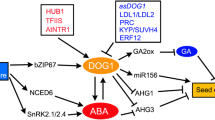Abstract
Under the conditions applied in our laboratory 4 1/2 days old plants ofChenopodium rubrum require 2–3 photoperiodic cycles for maximal flowering response, whereas 2 1/2 days old plants are able to flower after having obtained a single inductive cycle. The period length of the free-running rhythm of flowering observed in 2 1/2 days old plants after a single transfer from light to darkness is 30h and the first peak of flowering occurs at about hour 12 in darkness. When a cycle consisting of 16h darkness and 8h light or of 8h darkness and 8h light precedes the long dark period the rhythm is rephased. Rephasing is greater when the light commenced to act on the positive slope of the first peak of the free running rhythm than when it impinged on the negative slope. With an 8h interruption of darkness by light rhythm phase is controlled by the light-on, as well as by the light-off signal. Feeding 0.4 M glucose during the long period of darkness enhanced the amplitude of the flowering response and, moreover, substituted for one photoperiodic cycle.
Abstract
Za podmínek pěstování používaných v naší laboratoři vyžadují rostlinyChenopodium rubrum ve stáří 4 1/2 dnů po výsevu pro květní indukci 2 až 3 fotoperiodické cykly, kdežto 2 1/2 dnů starým rostlinám stačí jeden cyklus. U 2 1/2 dnů starých rostlin byl po jednorázovém přenosu ze světla do tmy pozorován přirozený endogenní rytmus kvetení, jehož perioda je 30hodinová. První maximum kvetení nastupuje asi 12 hodin po přensu rostlin do tmy. Jestliže před dlouhou periodou tmy byl předřazen cyklus 16h tmy a 8h světla (u 4 1/2 dnů starých rostlin) nebo 8h tmy a 8h světla (u 2 1/2 dnů starých rostlin), byla fáze rytmu posunuta. Posun fáze je větší, začíná-li světlo působit v době vzestupné fáze křivky přirozeného rytmu kvetení než v případě, že dopadne na sestupnou fázi. Je-li tma přerušena 8hodinovou periodou světla, je fáze rytmu určena jak dobou rozsvícení, tak dobou zhasnutí. Byly-li rostliny zásobeny v průběhu dlouhého období tmy glukosou v koncentraci 0,4 M, zvětšila se amplituda rytmu kvetení a navíc nahradila glukosa jeden fotoperiodický cyklus.
Similar content being viewed by others
References
Cumming, B. G.: Circadian rhythmic flowering responses inChenopodium rubrum L.: effects of glucose and sucrose.—Can. J. Bot.45: 1105–1115, 1967.
Cumming, B. G.:Chenopodium rubrum L. and related species.—In: (ed.)L. T. Evans, The Induction of Flowering. Some Case Histories. Macmillan of Australia, 1969.
Cumming, B. G., Hendricks, S. B., Borthwick, H. A.: Rhythmic flowering responses and phytochrome changes in a selection ofChenopodium rubrum.—Canad. J. Bot.43: 825 to 853, 1965.
King, R. W., Cumming, B. G.: Rhythms as photoperiodic timers in the control of flowering inChenopodium rubrum.—Planta103: 281–301, 1972.
Kinet, J. M., Bernier, G., Bodson, M., Jacqmard, A.: Circadian rhythms and the induction of flowering inSinapis alba.—Plant Physiol.51: 598–600, 1973.
Teltscherová, L., Pleskotova, D.: Nucleic acid synthesis inChenopodium rubrum L. during photoperiodic induction and its relation to endogenous rhythmicity.—Biol. Plant.15: 419 to 426, 1973.
Author information
Authors and Affiliations
Additional information
Address: Ke dvoru 15, 160 30 Praha 6-Vokovice, Czechoslovakia.
Rights and permissions
About this article
Cite this article
Teltscherová, L., Opatrná, J. & Pleskotová, D. Investigation of the endogenous rhythm of flowering inChenopodium rubrum L.. Biol Plant 16, 341–347 (1974). https://doi.org/10.1007/BF02920995
Received:
Published:
Issue Date:
DOI: https://doi.org/10.1007/BF02920995




